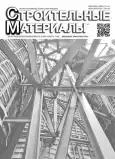Numerical simulation of construction 3D printing process. Problems and solution methods
- Autores: Slavcheva G.S.1, Telichko V.G.1, Yurov P.Y.1, Babenko D.S.1
-
Afiliações:
- Voronezh Technical University
- Edição: Nº 7 (2025)
- Páginas: 12-20
- Seção: Статьи
- URL: https://rjsvd.com/0585-430X/article/view/688687
- DOI: https://doi.org/10.31659/0585-430X-2025-837-7-12-20
- ID: 688687
Citar
Texto integral
Resumo
The numerical modeling methods of the construction 3D-printing process with concrete are analyzed from the point of view of the variable geometry printed objects stability numerical simulation possibilities. The method of computational fluid dynamics (finite volume method) implemented in CFD-complexes (ANSYS Fluent, OpenFOAM, COMSOL) was found effective for modeling and process control. The method and CFD tools applicability to solve the printing process modeling and controlling problem is determined by the numerical simulation possibility of concrete mixture flow during extrusion and layers formation, geometric conformity and structures stability prediction, taking into account the mixture rheological properties (viscosity, yield strength and thixotropy) and their change in time. A distinctive feature of the developed generalized approach and the 3D printing process numerical model is the mixture rheological parameters usage. The requirements for the nomenclature and range of its values have been determined experimentally. As part of this approach implementation experimental studies of rheological behavior by shear rheometry were carried out for three types of mixtures. During the model elements 3D printing their quality and stability in dependence with the mixtures type and technological characteristics were assessed. As a result, the rheological behavior rational model of and the values range of visco-plastic mixture parameters ensuring its suitability for extrusion and layering is substantiated. These include effective viscosity and Bingham yield strength, which determine the mixture extrusion quality; static viscosity and plastic strength, static yield strength, on which the layer shape, preservation and the printed structure stability are depended.
Texto integral
Sobre autores
G. Slavcheva
Voronezh Technical University
Autor responsável pela correspondência
Email: gslavcheva@yandex.ru
Doctor of Sciences (Engineering)
Rússia, 84, 20-letiya Oktyabrya Street, Voronezh, 394006V. Telichko
Voronezh Technical University
Email: katranv@yandex.ru
Doctor of Sciences (Engineering)
Rússia, 84, 20-letiya Oktyabrya Street, Voronezh, 394006P. Yurov
Voronezh Technical University
Email: yurov.py@yandex.ru
Postgraduate Student
Rússia, 84, 20-letiya Oktyabrya Street, Voronezh, 394006D. Babenko
Voronezh Technical University
Email: teleperedoz@mail.ru
Candidate of Sciences (Engineering)
Rússia, 84, 20-letiya Oktyabrya Street, Voronezh, 394006Bibliografia
- Liu Z., Li M., Weng Y., Qian Y., Wong T.N., Tan M.J. Modelling and parameter optimization for filament deformation in 3D cementitious material printing using support vector machine. Composites Part B: Engineering. 2020. No. 193. P. 108018. EDN: IKAVYD. https://doi.org/10.1016/j.compositesb.2020.108018
- Wolfs R.J.M., Salet T.A.M., Roussel N. Filament geometry control in extrusion-based additive manufacturing of concrete: the good, the bad and the ugly. Cement and Concrete Research. 2021. No. 150. P. 106615. EDN: DKLWJH. https://doi.org/10.1016/j.cemconres.2021.106615
- Hosseini E., Zakertabrizi M., Korayem A.H., Xu G. A novel method to enhance the interlayer bonding of 3D printing concrete: an experimental and computational investigation. Cement and Concrete Composition. 2019. No. 99, pp. 112–119. EDN: KTEMNJ. https://doi.org/10.1016/j.cemconcomp.2019.03.008
- Jayathilakage R., Rajeev P., Sanjayan J.G. Yield stress criteria to assess the buildability of 3D concrete printing. Construction and Building Materials. 2020. No. 240. P. 117989. EDN: ZSNDMP. https://doi.org/10.1016/j.conbuildmat.2019.117989
- Nguyen-Van V., Panda B., Zhang G., Nguyen-Xuan H., Tran P. Digital design computing and modelling for 3-D concrete printing. Automation in Construction. 2021. No. 123 (4). P. 103529. https://doi.org/ 10.1016/j.autcon.2020.103529
- Wolfs R.J.M.J.M., Bos F.P.P., Salet T.A.M.A.M. Early age mechanical behaviour of 3D printed concrete: numerical modelling and experimental testing. Cement and Concrete Research. 2018. No. 106, pp. 103–116. https://doi.org/10.1016/j.cemconres.2018.02.001
- Wolfs R.J.M.M., Suiker A.S.J.J. Structural failure during extrusion-based 3D printing processes. The International Journal of Advanced Manufacturing Technology. 2019. No. 104, pp. 565–584. EDN: AJPDUS. https://doi.org/10.1007/s00170-019-03844-6
- Vantyghem G., Ooms T., De Corte W. FEM modelling techniques for simulation of 3D concrete printing. Fib Symposium 2020 “Concrete Structures for Resilient Society”. 2020, pp. 964–972. https://doi.org/10.48550/arXiv.2009.06907
- Collins P., Van Helvoort S., Khimshiasvili G., Marsella A. Chapter 1 Prediction of Print Success for Concrete 3D Printing. Proceedings of the 148th European Study Group Mathematics with Industry. 2019. 27 p.
- Andersen S., da Silva W.R.L., Paegle I., Nielsen J.H. Numerical Model Describing the Early Age Behavior of 3D Printed Concrete – Work in Progress. RILEM Bookseries. In book: Second RILEM International Conference on Concrete and Digital Fabrication. 2020, pp. 175–184. https://doi.org/10.1007/978-3-030-49916-7_18
- Prem P., Ambily P., Kumar S. A theoretical model to predict the structural buildability of 3D printable concrete. Mechanics of Time-Dependent Materials. No. 28 (4), pp. 2661–2679. EDN: JNUBZH. https://doi.org/10.1007/s11043-024-09666-8
- Abbaoui Kh., Korachi I., El Jai M. 3D concrete printing using computational fluid dynamics: Modeling of material extrusion with slip boundaries. Journal of Manufacturing Processes. 2024. Vol. 118, pp. 448–459. EDN: KLMWGP. https://doi.org/10.1016/j.jmapro.2024.03.042
- Spangenberg J. and all. Numerical simulation of multi-layer 3D concrete printing. RILEM Technical Letters. 2021. Vol. 6, pp. 119–123. EDN: OSPDXA. https://doi.org/10.21809/rilemtechlett.2021.142
- Shoukat K., Muammer K. Numerical modelling and simulation for extrusion-based 3D concrete printing: The underlying physics, potential, and challenges. Results in Materials. Vol. 16. P. 100337. EDN: ZKIZES. https://doi.org/ 10.1016/j.rinma.2022.100337
- Dong A., Zhang Y.X., Yang R. Numerical modelling of 3D concrete printing: material models, boundary conditions and failure identification. Engineering Structures. 2023. No. 299. P. 117104. EDN: EHYLUB. https://doi.org/10.1016/j.engstruct.2023.117104
- Slavcheva G.S., Artamonova O.V. The control of rheological behaviour for 3D-printable building mixtures: experimental evaluation of «nano» tools prospects. Nanotehnologii v Stroitel’stve. 2019. Vol. 11. No. 3, pp. 325–334. (In Russian). EDN: NNOLZG. https://doi.org/10.15828/2075-8545-2019-11-3-325-334
- Slavcheva G.S. 3D-build printing today: potential, challenges and prospects for implementation. Stroitel’nye Materialy [Construction Materials]. 2021. No. 5, pp. 28–36. (In Russian). EDN: WACJMY. https://doi.org/10.31659/0585-430X-2021-791-5-28-36
- Yurov P.Yu., Karakchi-Ogli D.R. Influence of technological properties of cement mixture on the quality of layered 3D-printed elements. Vestnik Inzhenernoi shkoly Dal’nevostochnogo federal’nogo universiteta. 2025. No. 1 (62), pp. 139–154. EDN: HIZOBF. https:// doi.org/10.24866/2227-6858/2025-1/139-154
Arquivos suplementares














